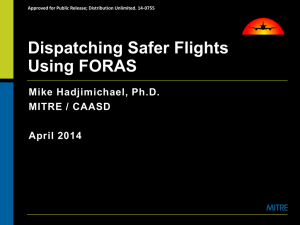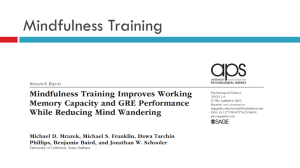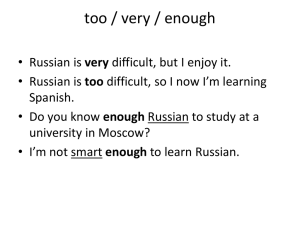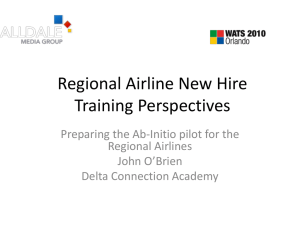Safety Risk Management Tools
advertisement
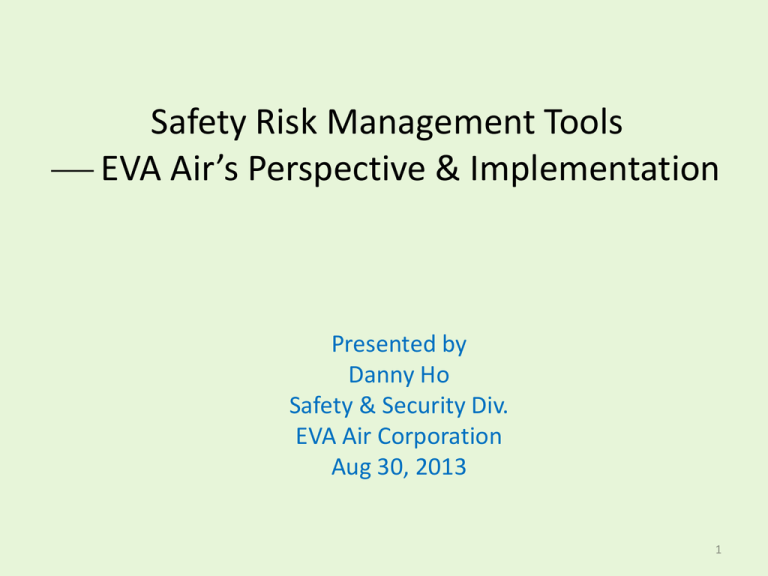
Safety Risk Management Tools EVA Air’s Perspective & Implementation Presented by Danny Ho Safety & Security Div. EVA Air Corporation Aug 30, 2013 1 Philosophy on Safety Risk Management Predictive thinking, proactive implementation and reactive response. Comprehensive, effective, feasible and sustainable. Effective safety management requires the ability to have the right system to collect and analyze the right information at the right time. 2 Safety Risk Assessment of Flight Operation -Traditional Practice Real Time Monitoring (ACMS/AHM) + Post Flight Analysis (FDM/FOQA) 3 Real Time Monitoring: ACMS & AHM MCD FSD Post Flight Analysis 90 80 70 50 40 30 WGBBS Daily Trend Analysis Hazard Identification & Risk Management FDM/ Aerobytes (QAR) Flight Data Animation DFDR A/C Performance Analysis FDM/FOQA Event Review Event Review Meeting Flight Data Alert Event FDM Daily Report Statistics/Data base Detect Event Training Improvement & Procedure Modification Quarterly Report Annual Report Trend Analysis Report Beside the real time monitoring & post flight analysis, what miss on Safety Risk Assessment of Flight Operation ? Before the flight! 9 Comprehensive Safety Risk Assessment of the Flight Operation Before the flight FORAS During the flight ACMS/AHM After the flight FOQA/FDM 10 FORAS Flight Operations Risk Assessment System • FORAS is a system which designed to capture risk attributes on the areas of crew, aircraft functionality and sector threats, and allow risk mitigation efforts could be deployed before the flight. 11 Flight Operation Risk • • • • • • • • • Newly check out Captain and F/O flying together Fatigued crew with MRT Non precision approach or ILS out of service Strong cross wind Low visibility with rain or snow Thrust Reverser INOP RWY is not grooved with percipitation The complexity of approach procedure & runway configuration Operating crew never operating into this airport before … Project Background FORAS concept generated by ICARUS Committee Think Tank of FSF Sponsored by : NASA Prototype Developed by : Dr. Michael Hadjimichel FORAS Development EVA AIR & Dr. Michael Hadjimichel System Introduction • FORAS is a methodology for generating a risk model, which produces a relative, quantitative measurement of a specific risk exposure in flight operations. – Gather the weather information, crew experience, navigation aids, and aircraft’s status etc. • A decision support tool to measure and reduce risk exposure. – A decision aids for risk awareness, not a GO or NO GO decision tool. • Proactive, predictive approach to aviation safety. – Analyze operational risks and take the actions of relevant risk mitigation to ensure a safe operation. 14 2. System Architecture CRTS: Crew Rostering and Tracking System FIS: Flight Information System SMIS: Safety Management Information System FORAS Fuzzy inference engine FORAS Models CRTS FIS EVA Database SMIS NOTAM FORAS CPI engine Weather System FORAS • Flight Operations Risk Assessment System DRV : Departure Risk Value ALRV : Approach & Landing Risk Value DRV & ALRV will be calculated automatically 2.5 hrs before the flight. Model structure DRV / ALRV • Crew Variable (Dep77;Arr85) • Sector Variable (Dep6;Arr11) • Aircraft Variable (Dep1;Arr1) Code TA01 TC01 TC02 TC03 TC04 TC05_C TC06_C TC07_C TC08_C TC09_C Rule Tables (Dep133;Arr166) Terminal value (T-value:Dep117;Arr146) T value definition Raw Data (D-Value: Dep116;Arr141) Code P001_1 P002_1 P003_1 P004_1 P005_1 P005_2 P006_1 Description Approach and Landing-related MEL Items Experience pairing Rank composition English proficiency Multi-nationalities Airport recency Special airport/runway Numbers of previous visits EVA type hours Flying recency as PF Description PILOT1 RANK PILOT1_GRADE PILOT1_NATIONALITY PILOT1_LASTTIME_AT_AIRPORT PILOT1_SECTORS_AT_RANK PILOT2_SECTORS_AT_RANK PILOT1_LIFE_TIME_HOURS 17 Crew Functionality Pilot Experience Intercrew Communication A/C Flying Experience Experience Pairing Rank Composition Airport Familiarity Pilot Fatigue Transient Fatigue Cumulative Fatigue Comm. Proficiency Airport recency Special airport/runway Numbers of previous visits 18 A/C Flying Experience Total Hours EVA type hours Pre-EVA hours Flying recency as PF Sectors EVA hours Type landing Landing at rank EVA landing 19 Transient Fatigue Pre-workload Previous sectors flown on this duty period Pre-flight Rest Duty hours since beginning In-flight fatigue In-flight Rest Pre-flight circadian night Duty hours of this flight In-flight rest hours Pre-flight rest hours Extra crew availability Crew bunk availability 20 Cumulative Fatigue Work Amount Previous Flying Pre-7 days workload Rest Schedule stability Pre-30 days workload Rest recency Rest amount Pre-90 days workload 21 Aircraft Functionality DRV & ALRV-related MEL B777-300ER DEP 22-11-09B Takeoff/Go-Around (TO/GA) Switches 32-42-01A Normal Antiskid Valve 32-30-01 Landing Gear Actuation System ARR 22-11-02B Autopilot Backdrive Actuator System 22-11-06B Mode Control Panel Switches-A/P Engage Switches 22-31-01 31-51-05A Autothrottle System Fleet A330 B747 B777 MD11 Items : 64 : 64 : 104 : 79 WES Autopilot Disconnect Warning Function 22 Sector Threat Airport Weather Weather Complexity Convective Wx Issues Precipitation Crosswind Components Visual Condition Ambient Light Ceiling Margin Visibility Margin 23 Airport ATC Functionality ATC control quality ATC English proficiency Approach Complexity A/P Familiarity Congestion Runway complexity Airport busy hour 24 Approach Complexity Flying Complexity Precision approach Approach go-around rate Special airport/runway Airport terrain/obstacle Runway Complexity Grooved runway Sunlight effective issues 25 Conclusion Why we need FORAS? • The core elements of Safety Management System is hazard identification & risk management. FORAS is playing a vital & predictive role on Safety Risk Management. 26 FORAS Promotion Program • Promote FORAS via a non commercial avenue • Airlines who are interesting to acquire FORAS shall donate certain amount of fund into FORAS Fund according to its fleet size. • Set up a FORAS Fund and manage it via a committee of trustees • The Fund will be utilized to set up FORAS Scholarship, FORAS Award and the future development of FORAS, and other aviation risk management initiatives. FORAS Promotion Program will be available on Q4 2013. Frontend Server DB Inference Engine Airline A Frontend Server Internet Inference Models Airline B DB Frontend Server Airline C DB XML Backend Workstation Thank you! Q&A 29
